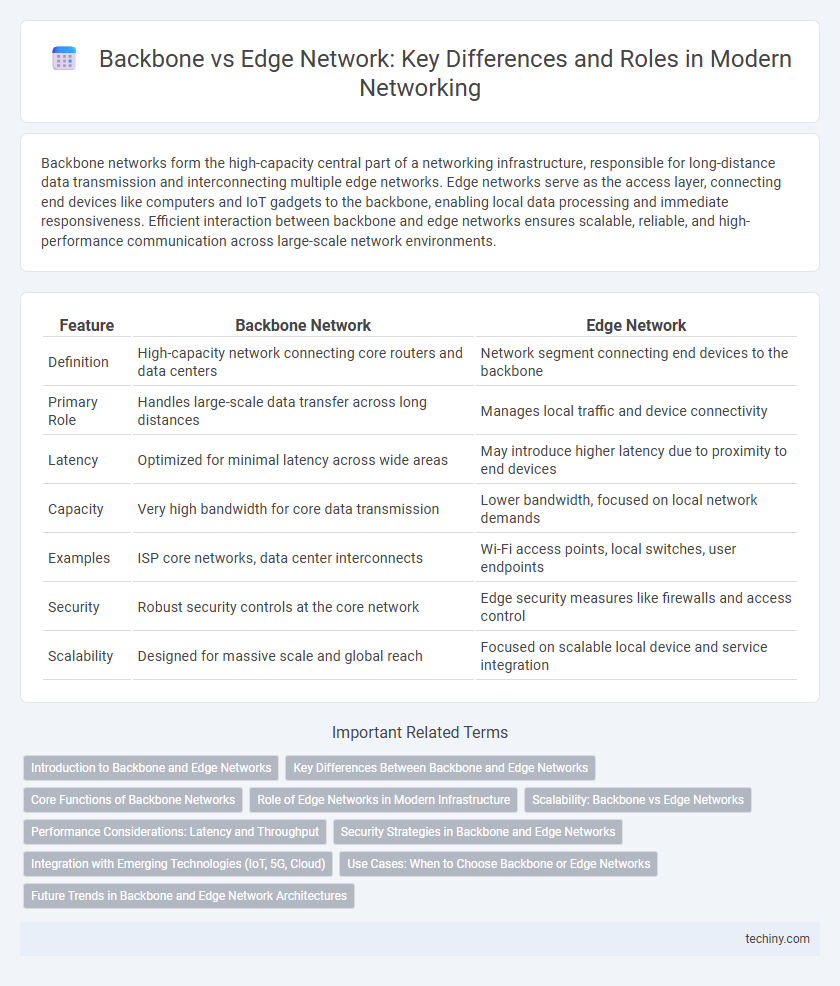Backbone networks form the high-capacity central part of a networking infrastructure, responsible for long-distance data transmission and interconnecting multiple edge networks. Edge networks serve as the access layer, connecting end devices like computers and IoT gadgets to the backbone, enabling local data processing and immediate responsiveness. Efficient interaction between backbone and edge networks ensures scalable, reliable, and high-performance communication across large-scale network environments.
Table of Comparison
| Feature | Backbone Network | Edge Network |
|---|---|---|
| Definition | High-capacity network connecting core routers and data centers | Network segment connecting end devices to the backbone |
| Primary Role | Handles large-scale data transfer across long distances | Manages local traffic and device connectivity |
| Latency | Optimized for minimal latency across wide areas | May introduce higher latency due to proximity to end devices |
| Capacity | Very high bandwidth for core data transmission | Lower bandwidth, focused on local network demands |
| Examples | ISP core networks, data center interconnects | Wi-Fi access points, local switches, user endpoints |
| Security | Robust security controls at the core network | Edge security measures like firewalls and access control |
| Scalability | Designed for massive scale and global reach | Focused on scalable local device and service integration |
Introduction to Backbone and Edge Networks
Backbone networks function as the primary data routes within large-scale networking infrastructures, interconnecting various subnetworks and ensuring high-speed data transfer across core regions. Edge networks operate at the periphery of the overall system, facilitating localized access and managing data traffic between end devices and the backbone. Distinguishing these layers enhances network performance, scalability, and efficient resource allocation.
Key Differences Between Backbone and Edge Networks
Backbone networks serve as the primary data routes within large-scale infrastructures, handling high-capacity traffic between core devices like routers and switches, whereas edge networks connect end users and local devices to the backbone, managing lower traffic volumes and providing access points. Backbone networks prioritize speed, reliability, and bandwidth to support data flow across wide and metropolitan area networks, while edge networks emphasize localized connectivity, device interoperability, and user access control. Key differences include their roles in data transmission hierarchies, scale and scope of managed traffic, and the types of hardware utilized for network management and security.
Core Functions of Backbone Networks
Backbone networks are designed to provide high-speed data transmission and reliable connectivity between different subnetworks or edge networks, ensuring efficient routing and scalable performance across large geographical areas. They handle the aggregation of traffic from edge networks, manage data flow prioritization, and support critical functions such as fault tolerance, load balancing, and high bandwidth capacity. By acting as the central infrastructure, backbone networks enable seamless communication between distributed systems and optimize overall network efficiency.
Role of Edge Networks in Modern Infrastructure
Edge networks play a crucial role in modern infrastructure by bringing data processing closer to end users, reducing latency, and improving application performance. These networks handle localized traffic and enable real-time analytics, supporting technologies like IoT, 5G, and content delivery networks (CDNs). By offloading data from backbone networks, edge networks enhance scalability and reliability in distributed computing environments.
Scalability: Backbone vs Edge Networks
Backbone networks offer high scalability by supporting large-scale data transmission across multiple locations through robust infrastructure and high-capacity links, ensuring efficient handling of increased traffic. Edge networks scale by distributing processing and storage closer to end-users, reducing latency and bandwidth demand on the backbone. Optimizing scalability requires balancing backbone network capacity with edge network deployment to manage growth and maintain performance.
Performance Considerations: Latency and Throughput
Backbone networks optimize high throughput and low latency by utilizing high-capacity fiber optic links, enabling rapid data transmission across long distances with minimal delay. Edge networks prioritize reducing latency for end-user devices by placing routing and processing resources closer to the data source, improving responsiveness for real-time applications. Understanding these performance considerations helps in designing scalable networks that balance backbone capacity with edge proximity to meet application-specific demands.
Security Strategies in Backbone and Edge Networks
Backbone networks implement centralized security strategies such as robust firewalls, intrusion detection systems, and encrypted data transmission to protect critical core infrastructure and ensure data integrity across high-capacity links. Edge networks prioritize decentralized security measures including endpoint protection, local access controls, and real-time threat detection to manage diverse and potentially vulnerable entry points. Both layers require coordinated policies combining network segmentation and continuous monitoring to defend against evolving cyber threats effectively.
Integration with Emerging Technologies (IoT, 5G, Cloud)
Backbone networks provide the high-capacity infrastructure essential for integrating emerging technologies like 5G and cloud computing by ensuring ultra-low latency and scalable data transport across core nodes. Edge networks optimize IoT deployments by processing data closer to the source, reducing bandwidth usage and enhancing real-time analytics for connected devices. Seamless collaboration between backbone and edge networks supports dynamic resource allocation and improves overall network efficiency in smart city, industrial, and autonomous systems environments.
Use Cases: When to Choose Backbone or Edge Networks
Backbone networks are ideal for high-capacity data transmission between major data centers or core routers, supporting enterprises and ISPs with robust, reliable long-distance connectivity. Edge networks suit scenarios requiring low latency and localized processing, such as IoT devices, content delivery networks (CDNs), and real-time applications at the network periphery. Selecting backbone or edge networks depends on whether the priority is centralized high-speed data transport or distributed computing closer to end users.
Future Trends in Backbone and Edge Network Architectures
Future trends in backbone network architectures emphasize higher capacity with the integration of 400G and 800G optical technologies, supporting increased data traffic from cloud computing and 5G deployments. Edge network architectures are evolving towards multi-access edge computing (MEC) and AI-driven automation to reduce latency and enable real-time data processing closer to end users. Both backbone and edge networks adopt software-defined networking (SDN) and network function virtualization (NFV) to enhance agility, scalability, and programmability in dynamic network environments.
Backbone vs Edge Network Infographic

 techiny.com
techiny.com